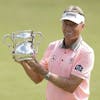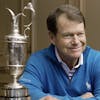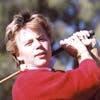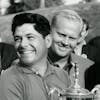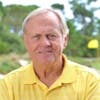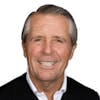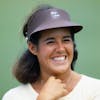Mike Weir - Part 1 (The Early Years)
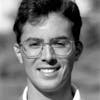
In the first episode of a compelling five-part series, "FORE the Good of the Game" hosts Mike Gonzalez and Bruce Devlin embark on an insightful journey with 2003 Masters champion and Canadian golf icon, Mike Weir. This episode delves into Weir's early life and the formative experiences that shaped his remarkable career.
Listeners will be captivated as Weir recounts his humble beginnings in Sarnia, Ontario, where his passion for golf was kindled against the backdrop of a sports-driven community. Weir shares candid anecdotes about growing up as the youngest of three brothers in a blue-collar town, emphasizing the role of family and community in his development. His tales of transitioning from playing baseball and hockey to golf offer a unique perspective on the makings of a multi-sport athlete.
The episode further explores Weir's early encounters with golf, including the pivotal moment when he met his idol, Jack Nicklaus, and how this experience influenced his commitment to the sport. Weir's journey from using a limited set of golf clubs to obtaining his first full set is a testament to his dedication and resourcefulness.
Listeners will also gain insight into Weir's amateur career, his approach to learning the game, and the challenges he faced as a left-handed player in a predominantly right-handed golf world. The episode highlights key moments that fueled Weir's ambition, leading him to consider a collegiate golf career.
Join us in this intimate and revealing conversation with Mike Weir, as we uncover the roots of his golfing journey and the experiences that laid the foundation for his future success. This episode is a must-listen for golf enthusiasts and anyone interested in the inspirational story of a true champion.
Tune in to "FORE the Good of the Game" for this exclusive series with Mike Weir, and don't forget to subscribe and share with fellow golf fans!
Follow our show and/or leave a review/rating on:
Our Website https://www.forethegoodofthegame.com/reviews/new/
Apple Podcasts https://podcasts.apple.com/us/podcast/fore-the-good-of-the-game/id1562581853
Spotify Podcasts https://open.spotify.com/show/0XSuVGjwQg6bm78COkIhZO?si=b4c9d47ea8b24b2d
Google Podcasts https://podcasts.google.com/feed/aHR0cHM6Ly9mZWVkcy5idXp6c3Byb3V0LmNvbS8xNzM3Mjc1LnJzcw
About
"FORE the Good of the Game” is a golf podcast featuring interviews with World Golf Hall of Fame members, winners of major championships and other people of influence in and around the game of golf. Highlighting the positive aspects of the game, we aim to create and provide an engaging and timeless repository of content that listeners can enjoy now and forever. Co-hosted by PGA Tour star Bruce Devlin, our podcast focuses on telling their life stories, in their voices. Join Bruce and Mike Gonzalez “FORE the Good of the Game.”
Thanks so much for listening!
Music playing 00:00
Mike Gonzalez 00:15
Welcome to another edition of FORE the Good of the Game and Bruce Devlin, we've got a repeat guest this morning. I think we told him at the time we first met with him a couple years ago, he was the youngest guest we ever had. Well, that's not true anymore, is it?
Devlin, Bruce 00:28
It's not, but he is still young, by the way. And for those of you who remember, this left-hander from Canada has 14 professional wins. Eight on the PGA Tour and of course, capped by his Masters victory, and it is a pleasure. Welcome aboard there. Mister Weir. Glad to have you back.
Weir, Mike 00:52
Thank you Bruce & Mike. Yeah. Glad to be back. Thanks for having me.
Mike Gonzalez 00:55
Good to have you. And let's just let the record show you've got your winter growth started, your downtime has started, hasn't it for the winter?
Weir, Mike 01:03
The downtime has started. The snow is starting to fly. So this keeps me more on the ski hill the next couple of months.
Devlin, Bruce 01:09
There you go.
Weir, Mike 01:11
We'll shave it off once golf season start again.
Mike Gonzalez 01:15
So great to have you. Just to remind our listeners last time, we sort of focused on your professional career and really focused in on the Masters. And this time, we want to kind of back up and start where we normally start, which is at the very beginning. And so we want to spend a little time just getting to know what life was like growing up in Ontario and how you came to learn the game of golf. So let's just go way back to May of 1970.
Weir, Mike 01:41
Yeah, that's when I was born in in Sarnia, Ontario, Canada, and you know, the youngest of three brothers. My older brothers are seven and 10 years older than me. So I like to joke with my parents that I kind of was a mistake that had happened along the way. But, you know, it was a great place to grow up, you know, blue collar town, hardworking town, a lot of factories and that sort of thing in our town, but it's a really tight knit community, very sports-driven community. A lot of great athletes, in particular, hockey players have come out of Sarnia. And I don't know, I mean, I think as I grew up, and my father introduced me to different sports. You know, fast forward to probably 1977 or 1978 when he introduced me to golf at a young age, you know, just a couple of times in the summer, I liked it, we went to a little par-three course there was a Holiday Inn hotel that had a little par three course on the back, and that's where he introduced me to the game. But I was a baseball player, when I was young started, you know, four or five, six years old, four or five, something like that playing T-ball and, and then furthering into baseball. That was the summer sport and then, of course played hockey in the wintertime, which most Canadian young men do and most of the girls too. Such a passionate sport up there. And yeah, I think, you know, having two older brothers to kind of try to keep up with who actually pushed me as I got a little bit older, playing the sports. Like I said, golf was just, I dabbled in it while I was playing baseball. But probably it was probably about 1980 when we my family moved from the city which was about 50,000 people in Sarnia to a little town called Brights Grove which is just on the outskirts of Sarnia and and we moved across the street from a Golf Course you know, I like to say you know about a 7-10 minute bike ride to the Golf Course. And you know, I was looking for a summer job when I was about 10 or 11 and rode my bike over to the club and you know started, well my dad actually had a membership at this golf club called Huron Oaks they had a corporate membership with the company that he worked with and he's said why don't you go out so you can get a job over there for the summer. So I went over there on the pro Steve Bennett saw that was pretty small. He didn't know if I could handle working at such a young age but he gave me the job and it was just the back-of-shop kind of stuff, picking the driving range, cleaning members clubs when the clubs came in and racking them in the in the club storage and that sort of thing, cleaning the carts, all that kind of thing. So with that, with working there, I was able to have access to the driving range and the Golf Course on my off-time. So that's when golf started to become a little bit more in my life and not just the odd time summer thing. Baseball started to fall by the wayside probably by the time I was about 13. My baseball coach kept saying you're getting too much of a golf swing in your baseball swing. I was a decent baseball player. I was a I was a lefty pitcher and first baseman. And I think the baseball coach was a little bit upset that I wasn't spending as much time on baseball anymore. But, golf started to become more of priority around that time.
Devlin, Bruce 05:18
So did you did you caddie while you were still doing some work at the club there?
Weir, Mike 05:23
There wasn't we didn't have really caddie program at the club like I know a lot of Australian courses do. I think maybe in the bigger cities like Toronto and things and some of the clubs there, they probably had some caddie programs. In fact, I know at the National Golf Club in Toronto where George Knudson used to, when he retired, that's where he did a lot of his teaching and there in Oakdale and he did a junior clinic that a few of my friends used to go to up at the National they had a caddie program up there but in my little hometown it was just a small little club and yeah, there was no caddie program so it was just that back shop work cleaning the range and such.
Mike Gonzalez 06:00
Nine holes. 18 holes?
Weir, Mike 06:02
It was 18 holes, very open front nine and the back nine ,where I like to tell people where I guess my game kind of started to hone in a little bit more, was very tight back nine with very sharp doglegs. You had to be really precise off the tee. The greens had some elevation and some some fall off in areas so that's where a short game came in handy and working the ball left to right, right to left, on that back nine was was really important.
Mike Gonzalez 06:33
Now by this time were your brother's into golf as well or were you the pioneer in the family after your dad.
Weir, Mike 06:40
I was pretty much the pioneer. I mean, my brothers played but I was the one that was really, really taking it seriously. They kind of dabbled in it. But yeah, I was the one that was at the Golf Course, all day every day. I mean, I was either working my shift from seven to two and then two o'clock till dark I was practicing or vice versa. If I had the two o'clock to close shift, I was there in the morning till dark, in the summertime. And then during school time, you know, I go over right after school and sometimes work the closing shift or, or if I wasn't working that day practice. And so that started kind of ramping up there when I was about 12 or 13 years old.
Devlin, Bruce 07:17
You got to meet a you got to meet a pretty good player I understand back when you were 11 or 12 years old too. A guy who's been able to win a couple of golf tournaments. Tell us about that.
Weir, Mike 07:28
Yeah, Jack Nicklaus came to play our home club and play an exhibition match against our head pro Steve Bennett. I think this was 1981. So I was 11. And because Jack was Steve's favorite player, he quickly became my favorite player. And then, obviously when he came to our club, it was just such a big thrill for our club and to get around watching them warm up and and then to see him live. And actually it was later that summer that I got to go to my first professional event. I went to the Canadian Open later that summer. So that was the first year that golf to me was like my eyes were wide open to how cool Professional Golf was going to the Canadian Open for the first time that summer seeing Jack Nicklaus up close, Canadian Open seeing Johnny Miller and Andy Bean and Tom Kite did a clinic on the range for us juniors and when they were done, they had a big bucket a Titleist of balls, and they dumped all the balls to us juniors and we were filling our pockets with all the golf balls. We thought it was the greatest thing ever. And that's I think the first time I thought like, wow, professional golf, this is really cool. I want to try to do this.
Devlin, Bruce 08:42
Yeah.
Mike Gonzalez 08:44
So, Nicklaus comes to town for this match. Was this just a special trip in or was there another event? I would have thought maybe it would have been connected with the Canadian Open that year.
Weir, Mike 08:55
I think it was maybe the Monday of the Canadian Open. And I think it was a corporate deal for Jack and the company my father worked for it was a company, a polytechnical company called Poly Sar. And they had brought Jack in for the day to do this outing and played with played with Steve and I think they had the top junior in the day. It was a guy named Steve Purvis and he got to play with them. And they played the full 18 hole match and so it was cool to see Jack up close.
Mike Gonzalez 09:27
So you're watching this thinking, I didn't realize a human being could do that with a golf ball.
Weir, Mike 09:34
Yeah,
Devlin, Bruce 09:35
He was pretty amazing!
Weir, Mike 09:35
Exactly, I don't remember a lot about the day I do remember just kind of watching him you know, I think you know, watching the golf ball being struck I think I remember it, how high he hit it. That was different. As a junior player, I had a very strong grip and pretty shut clubface at the top and I hit the ball so low and I think I remember thinking like how does he hit the ball so high? I think that was what was running through my mind? He could hit it high, that's for sure.
Mike Gonzalez 09:37
Yeah, Bruce, you had a lot of up close encounters with Jack. I'm sure you had those same thoughts running through your mind too.
Devlin, Bruce 09:46
Yeah, well, of course, as you know, Mike probably doesn't know. But I first met Jack in 1960. Through connections, I got to go to Columbus, Ohio and practice with him before he and I went to St. Louis to play in the U.S. Amateur in which Deane Beman beat both of us by the way, one in the quarters and one in the semi. So we got to drive back to Ohio wondering how the hell we lost to Deane Beman. But anyhow,
Mike Gonzalez 10:44
He was pretty good, though.
Devlin, Bruce 10:45
Yeah, he was good and you know, the one thing I don't know if Mike knows this or not but one thing about Deane Beman was he was the first guy that ever did the pacing to the greens. He could spot at a tree and he'd walk to the front of the green and so he was a guy that started that. Jack gets a lot of credit for it but I think Beman was the first one that ever did that.
Weir, Mike 11:12
I didn't know that. That's cool.
Devlin, Bruce 11:14
Yeah.
Mike Gonzalez 11:14
But anyway, just you know, getting back to Nicklaus. Of course, Bruce had a lot of up close, seeing that sort of ball flight. And it was even intimidating back then, wasn't it Bruce?
Devlin, Bruce 11:25
It sure was, yeah, particularly down wind, it was just I mean, it wasn't even a contest for most of the guys. He could hit it way by everybody.
Weir, Mike 11:35
I remember Gary Player telling me that into the wind with obviously the technology and the ball. He said he could kind of keep it fairly close to Jack down wind when he could hit it, he'd just be 50 yards by everybody down wind.
Devlin, Bruce 11:51
Interesting
Mike Gonzalez 11:51
And that's exactly what I've heard Bruce say a number of times on this program is exactly what you just said. Your connection with Mr. Nicklaus didn't end at age 11 did it, because you were inclined to write him a little letter for some advice, I guess a little bit later in your younger life.
Weir, Mike 12:12
Yeah, it was maybe the following year. And as I was starting to get a little better at the game and Junior Golf and things and talking with my dad, I started to notice that there weren't really any lefties out there. And you know, I remember going to that Canadian Open and there was a guy Ernie Gonzalez and Russ Cochran, I think were the two that were playing at the time but you know, the top players, everybody was right handed so in my head, I'm like, Dad, should I you know, and there was a time when when fathers were switching a lot of their sons and daughters over to be right handed because you're supposed to be right-hand in the game. I asked my dad and he's like, Well, I don't think so. I think you can keep going left-handed and it was tough to find equipment. I didn't have a sand wedge at that time. There was nowhere to find a sand wedge. I had a three, five and seven iron. I had a driver and a five wood and, when I got a bunker, I opened the face with my pitching wedge and so equipment was a little bit difficult and I remember saying to my dad, maybe I should read Mr. Nicklaus and see what he thinks. He said, Well, okay, you write a letter, let's figure out how are we going to get him a letter and I believe he was writing for Golf Magazine at a time. I don't think it was Golf Digest, but Golf Magazine. And so I drafted up a letter and filled it out to, you know, the back of the magazine, the address was there and send it into Golf Magazine attention, Jack Nicklaus. And somehow, they must have forwarded on to his office and, sure enough, a couple months later, I got this note back saying "No, Mike, you should stick to your natural swing and you know, keep working at it." And then he plugged his book a little bit he said, you know, in my book "Golf my Way" in the back, there's a section dedicated to left handers. Maybe you should read that and I said okay. So, I got the book and, you know, the rest is history, but I shared that story with Jack a few times and he gets a chuckle with it every time.
Devlin, Bruce 14:21
So when did you when did you first get a full set of left handed golf clubs.
Weir, Mike 14:27
I think my first full set was probably 1984.
Devlin, Bruce 14:34
So you're 14 years old?
Weir, Mike 14:36
I was just 14. So I got a Christmas card from Steve Bennett, our pro at the club and opened up the card and it was a picture of this Wilson Staff Dynamic Iron, just a little photo. And he said Merry Christmas, these have been ordered for you. So it was Steve who ordered my first out of irons. And I remember when they came in sometime in the spring and they had the old leather wrap,
Devlin, Bruce 15:07
They were beautiful weren't they?
Weir, Mike 15:09
It was just beautiful. I'd scrub those things down, make them as tacky as they could be, always. Then, it was later that summer that I was playing a junior tournament and won a bit of a gift certificate to the pro shop. At a course in London, Ontario. I believe it was Sunningdale Golf Club and I went in the shop with my gift certificate. I looked on the wall and there was a left-handed Gene Sarazen R90 sand wedge. Left-handed. And it was a steel shaft but it had the color like it was wood, the paint-on wood. And I used my gift certificate to get this sand wedge and that was my first sand wedge. It was a Gene Sarazen R90 back in 1984.
Mike Gonzalez 15:56
So tell us a little bit more else about the equipment you were playing back then. I mean, I'm trying to remember Big Bertha and the timing and everything else. Were you playing wooden clubs when you started?
Weir, Mike 16:06
Yeah, wooden clubs. And I remember they were an iron called Spalding Kroydons. And they were
Mike Gonzalez 16:13
Did they have kryptonite in them or something.
Weir, Mike 16:18
I remember the woods were like a black head, painted wood. And then the irons. Tough time remembering exactly what those looked like but probably very small. But it was just the 3, 5, 7 and nine and they were from a neighbor. They were a gift from a neighbor from across the street that I got when I was about eight or nine years old and I used those until Steve got me the set of Wilson staffs in 1984.
Mike Gonzalez 16:45
Yeah, I think I had a set of maybe Wilson Staff irons back in that era. I had a good buddy that started his career at Wilson in like 1978 and moved over to Titleist, but one iron through wedge.
Weir, Mike 17:00
One iron through wedge. Yeah. The old one iron. Bruce probably played a one iron.
Devlin, Bruce 17:05
I did for a while. But as a matter of fact, I still have a couple of them. I look at them and I think how did we ever play with something like that? It's amazing.
Weir, Mike 17:18
Yeah, exactly. In fact, I played persimmon all the way up until college. I think it was my maybe second year of college that I got my first TaylorMade, I think it was the Burner that came out. A little TaylorMade head that came out that I used the first time other than that I had a Cleveland Classic I used as I got into my later teens and just into college age was The Cleveland Classic wooden driver.
Mike Gonzalez 17:45
You probably knew a few other natural left handers that played right handed didn't you on the tour. Do you remember anybody. I can think of a couple guys.
Weir, Mike 17:53
Well, Phil, I know Phil is. I mean Phil is the same as me. Writes right-handed, plays left. I'm a little you know, when I play tennis, I serve with my left hand and then play with my right . Kick with my left.
Devlin, Bruce 18:09
I've never seen that before.
Weir, Mike 18:11
Yeah, so that's a little bit messed up. But that's what I do.
Mike Gonzalez 18:15
How about pool shooting? Left-handed ,right-handed?
Weir, Mike 18:17
Right handed. Right handed.
Devlin, Bruce 18:19
Yeah, horseshoes.
Weir, Mike 18:25
Left-handed.
Mike Gonzalez 18:25
You're confused.
Devlin, Bruce 18:27
Isn't that amazing though.
Mike Gonzalez 18:29
Well, a good buddy of Bruce's from Australia.,David Graham was a natural left hander.
Weir, Mike 18:36
Was he?
Devlin, Bruce 18:36
Yes, he was. He sure was.
Weir, Mike 18:38
Okay.
Devlin, Bruce 18:39
And he switched around. I think Curtis Strange, he kind of sounds like you. I mean, Curtis would do some stuff left, some stuff right but he ended up just settling on the right side.
Weir, Mike 18:49
I wonder what Bob Charles was? Let's he a natural righty?
Devlin, Bruce 18:53
No, he was a lefty.
Weir, Mike 18:55
He was a lefty all the way?
Devlin, Bruce 18:57
Yeah.
Mike Gonzalez 18:58
Yeah, I'm trying to remember if that even came up with him whether he even toyed with the idea back in his early days in the 1950's.
Devlin, Bruce 19:05
I don't think he did.
Weir, Mike 19:06
Talk about trying to find equipment back then.
Devlin, Bruce 19:08
Think about that, back in the 1960s. Early 60's.
Mike Gonzalez 19:14
And the ball. Did you have a chance to play the small ball at all when you were a kid?
Weir, Mike 19:20
A little bit. They were around a little bit around my club. Some of the members had them and would give them to us sometimes. I never played it in an event. We just kind of played it for fun for nine holes or something just to see what it was like. I remember it flying really low. Remember, putting was kind of weird when you put it when you look down?
Devlin, Bruce 19:43
I think it was 1978 when the British ball was converted to the American ball, the 1.68" insted of the 1.62". I think it was 1978. And then there was a time then when we could play two balls in around a golf. Did you get to do that?
Weir, Mike 20:09
No.
Devlin, Bruce 20:09
Oh yeah, we used to, but I didn't. But I remember playing with Bobby Nichols at the PGA in, in North Carolina and we get to the I don't know 12 or 13 hole, long par three, and he pulls out a solid ball. What were they call them
Mike Gonzalez 20:26
Oh, like a Top Flite.
Devlin, Bruce 20:28
Yeah, the Top Flite solid ball. He used to play them on the par three's because they were too hot, you couldn't curve them very much. And they penetrated a lot better. So, who would have known that we all ended up with golf balls without any liquid centers. Amazing.
Weir, Mike 20:47
Yeah, it's changed a lot that ball. It's hard to curve it nowadays, that's for sure.
Devlin, Bruce 20:52
Yeah.
Mike Gonzalez 20:53
Yeah. I mean, you really spun those old Balata Titleists, back in the day with the small persimmon heads, and they start talking about rolling back this and rolling back that. Well, all you've got to do is just give you guys a spinny ball and look out.
Devlin, Bruce 21:07
Yeah, that would make a difference for sure.
Weir, Mike 21:11
Yeah
Mike Gonzalez 21:11
You wouldn't swing 130 at a spinny ball, would you?
Weir, Mike 21:16
No, no. You'd be worried if you mis-hit that thing at 130, boy.
Mike Gonzalez 21:22
So you talk about golf kind of taking over from baseball as you kind of finished up little league years, I guess. 12, 13 years old. But you still have hockey in the wintertime. So that was probably still a serious sport at that age for you wasn't it?
Weir, Mike 21:36
It was, yeah, Yeah, I was still playing competitive hockey at that time. And Golf was just a summer sport. I think it was probably by the time I was about 15 or 16 when I started getting a little bit better even then at golf that my dad decided to drop a net down in our garage in the wintertime and could hit some balls indoors, of course, you know, with our winters it's a long winter up there. So at least I could swing a little bit in the garage. And I would also collect balls that I'd find in the ponds and creeks around our club and i'd save those all winter. And then on a decent day in the wintertime I'd go down to our lake and I'd clear off a little patch of snow and I'd hit balls out into the lake, which was always fun. You couldn't go collect them because it was too dangerous to go out there. But we would fire golf balls out there. But yeah, hockey was pretty much from November, maybe even late October through through March, early April and then golf would start to pick up after that.
Mike Gonzalez 22:41
Yeah. Well, Bruce, you might know but Bruce was a hockey player too.
Devlin, Bruce 22:45
Yeah, you and I both played hockey. Mine was a little different to yours. Mine was on the ground . Yours was field hockey. I was a field hockey player.
Mike Gonzalez 22:55
But he had some, like you have good hockey players coming out of your town. He had some pretty good field hockey players came out of his as well.
Devlin, Bruce 23:00
I did. A little town I grew up in, about 11,000 people. We had three Olympians that were hockey players. Yeah. So it was a big sport in my little town. There were probably 10 teams, male teams of hockey in the one little town of about 11,000 people, which is quite remarkable when you think about it. But yeah, it was a great sport.
Mike Gonzalez 23:28
Well, what's become very clear to us, Mike since the first time we got together with you a couple of years ago now that we've had several other interviews behind us. It's just a commonality across all these great players. They're multi-sport athletes, a lot of hand-eye sports they are involved in. So you talk about hockey, field hockey, ice hockey, baseball. Just fits right in.
Weir, Mike 23:51
Yeah, I agree. I mean, I get you, you probably get that to Bruce, sometimes where a parent will come and say, Hey, what's the best way to get mychild in the game? And, you know, what about coaching and all this even at very young ages, I'm like, let them play everything. Don't make them so focused at such a young age, they'll likely burn out and I think being a functional athlete in all these other sports really, if the kid decides to go into golf, it'll just serve them well, that they're good at other things, their hand-eye and just athleticism in general will help them in golf if they play other sports.
Devlin, Bruce 24:27
I agree with you.
Mike Gonzalez 24:28
Yeah, I think our other guests have been pretty much unanimous in terms of advocating multiple sports, developing the full body.
Devlin, Bruce 24:36
Understanding the team spirit as well.
Mike Gonzalez 24:42
Yeah, I mean, probably the most extreme example. I've heard of parents and kids going over the edge. And you may have heard this story, but I've heard of kids, young kids, 13, 14. Up and coming pitchers, that have proactive, Tommy John surgery before they even have an elbow problem to strengthen that area.
Devlin, Bruce 25:03
Isn't that amazing
Weir, Mike 25:04
Oh wow, no kidding. I've never heard that. That's,
Mike Gonzalez 25:06
Is that over the top?
Weir, Mike 25:07
That's way over the top.
Mike Gonzalez 25:10
So tell us a little bit about, over time as a young man, how you came to learn the game. We've talked to players from all different eras, starting back in the 1950s. And, of course, in the 1950s, even the 1960s, there wasn't as much to see and experience in terms of videos and television. Your era was somewhat different but where did you really learn ,beyond a professional teaching you, was it through observation, through reading, through watching? What was it?
Weir, Mike 25:41
Yeah. Yeah, it is interesting. I think at a young age, it was just all athleticism and how to get that ball in the hole. So I think without even knowing it, it was a lot visual, it was the competitive spirit of trying to get the ball in the hole. This club I said I grew up at and working at, there was a lot of really good juniors there and a lot more older than me. And a lot of the time, they were nice enough to let me tag around for around a golf with them, even though they may have been 16 or 17 and I was 13. So I was quite a bit behind them off the tee. So I guess my competitive spirit of like, how am I going to beat these guys or keep up with them was like trying to fit a four wood close to the hole when they were hitting a seven iron, and everything just kind of kind of just figuring it out on my own. But I did have Steve, who I mentioned before, Steve Bennett. He would work with me and work on my game. And it was just a lot of feel. It was a lot of see the target, get my hands, he was big on using your hands, which a lot of the teachers don't want to do that today. But he would always say the back of my right hand to the target. That's what he would always say. That was his thing that I can still hear him saying to me on the range. Make sure that back of the right hand gets to the target, don't let it flip, make sure the back of the hand gets to the target. And then I didn't really start to learn about technique really, too in depth, until I got to college. And I had some teammates on my team who were using plane boards and doing things and I thought it was a little bit of nonsense. I really didn't dabble in it. But that was the first time I had seen guys really working on their swings. I did it through just hitting balls and practicing. And I guess if I think of college, we used to hit balls on our practice football field at BYU. And and we had to shag the balls ourselves. So we would we would line up on a line on one of the football lines. And we set a shag back out there and we'd have to hit it down the line. And you didn't obviously didn't want to veer too far off the line because you'd have to be searching for your golf balls all the time. So, we put the shag bag out there 100 yards and hit balls to the shag band. Go collect them. Go put it out there 150. Go hit them. Put it at the 200. Go hit them, collect them. So I think it was just by repetition. I didn't even know what I was doing. Really, I was just trying to hit it to the bag. And I probably had Steve's image of the back of my right hand at the target. But other than that, that was basically it in my early days.
Devlin, Bruce 28:22
You didn't read any books or magazines?
Weir, Mike 28:25
I guess that Nicklaus book was the only book that was it. It wasn't until my early 20s after college where I started to see a few of my friends getting better and started talking with them. What are they doing? Well, this guy's working with this coach that works under David Leadbetter. Oh, what's he teaching? And then I started thinking, okay, there is maybe a little bit more depth to this and I started reading some articles from David Leadbetter, which led me to Ben Hogan's "Five Fundamentals."
Devlin, Bruce 29:03
A lot of people ended up there, don't they Mike? The "Five fundamentals" by Mr. Hogan.
Weir, Mike 29:07
Yeah.
Mike Gonzalez 29:08
You can't imagine how often Hogan's book has come up in these discussions.
Devlin, Bruce 29:12
Amazing.
Weir, Mike 29:14
Yeah, yeah. It's probably the standard that most players have looked through.
Devlin, Bruce 29:20
Tell us about your early victories as a young amateur. Where did you collect your first victory?
Weir, Mike 29:30
My very first victory it was special because it was at that course called Seaforth Golf Club in Ontario. And that's where Steve my pro grew up. And that's where he came from. He grew up at this course and then came to our club to be the Head Pro. So, he signed me up for the junior tournament there. I was 13 and back then it was a nine-hole course. It's 18 now. You'd play nine, break for a little bit and then play the nine again and my best score ever was 79, going into this junior tournament and I go there and I shoot 36 the first nine holes, and I'm ecstatic you know, just shoot 36 and I chipped in and made a couple of long putts and we make the turn again and in my head. I think,
Devlin, Bruce 30:19
I gotta beat 43.
Weir, Mike 30:21
Yeah, exactly. Exactly.
Mike Gonzalez 30:23
We all think alike huh?
Weir, Mike 30:25
Yeah, we all think alike. If I shoot 42 I'll break my personal best. Well, I shoot 34.
Devlin, Bruce 30:31
Oh, my goodness,
Weir, Mike 30:33
I shoot 34 and I shhot 70 and I break my best by nine shots, in a tournament. And, I'll never forget the older juniors coming over to the guys I played with and they thought, well, he must have cheated. Something must have happened because I won the 18 and under. I won the whole thing, not just the 13, the Bantam Division. I won the whole thing and the juniors are like no, and I remember curling this 40 foot putt, it may have been a 25 foot putt, on the last hole. Probably about an eight foot curler. And it was probably going off the green and it went in. And I just couldn't believe it that I shot this 70 and I won the tournament. That's what really kind of got me going for the rest of the summer. I thought I can I can I can be pretty good at this.
Mike Gonzalez 31:22
Yeah, I bet. So tell us about the competition. Did you travel a lot throughout Canada? Did you come to the U.S. much what was that like in your early amateur career,
Weir, Mike 31:33
Early amateur career, mostly in Ontario. When the AJGA did come to Michigan, which was right across the border from Sarnia, I did go play that tournament across the border in Michigan. I think it was a Elks Course across the bridge that I played every year. And probably by the time I was about 16, that's when I start thinking oh, if I wanted to play college golf, I better start playing some more. And I'd go over to Michigan to try to qualify for the U.S. Junior. But a lot of it was Ontario golf. And then if I qualified, more the national things, our national Canadian Junior and Canadian Amateur from there. So we had a good circuit, we had a circuit in southwestern Ontario called the Tyson Tour, where we would travel around, like I said, at our club where there was, you know, seven or eight of us really good juniors and some of the older boys would drive. And, within probably an hour radius was this Tyson Tour that we'd play all summer and you'd accumulate points throughout the year, and if you did well, you'd be the winner at the end of the year. And that's where, you know, I won that gift certificate on that Tyson Tour to get my first sand wedge and so, it was a lot in southwestern Ontario, and then we'd have our provincial championships. And then if you played well in those you got to go on to the national championships.
Mike Gonzalez 33:00
Well, you know, we all have our memories, don't we as kids growing up and you kind of measure yourselves against who's in your town. And then you get a chance to play regionally or maybe state or province level. And then at some point, some of us are maybe fortunate enough to compete at a national level. And at every level, you're like, Whoa, I was Kin Tut here in my little town, but boy, there are some good players around.
Weir, Mike 33:25
Yeah, yeah, I quickly realized that, you know, I think, as I you know, probably by the time I was 15, or 16 started getting some more of the provincial events and the national events, I think I started realize how good the guys were in our hometown of Sarnia. Because it seemed like we were all close to the lead in some of the provincial things. And then even in the national events, some of us were creeping up near the top of the leaderboard. So I was kind of blessed, I guess, to grow up with such tough competition at my club all the time to when we were playing that a lot of the guys were really good and some of them went on to the State Amateur and won the Ontario Amateur and guys would be contending in the Canadian Amateur. So I did grow up in an era in my hometown, where there were some really good players.
Mike Gonzalez 34:13
Yeah. How old were you? When you you kind of started thinking about what I probably want to play this collegiately somewhere? Where am I going to go? What was that process like for you?
Weir, Mike 34:25
Yeah, it was 15 or 16. And there wasn't really college golf in Canada at that time. It's a little bit better now. There's some opportunities in Canada, but yeah, it was definitely the U.S. And so the way I went about it, my dad helped me draft a letter and I sent it out to about 50 U.S. colleges. Just send out a resume my junior record, what I was doing, how my school was going, what kind of grades I was getting. My dad helped me draft that and we sent it off to place at probably 50 schools. And this was probably one of was 16 years old. And let's say I got 10 of them back, 10 letters back from coaches, hey, keep us posted the next couple years. And then probably by the time I was 17, keeping in contact with those 10. It probably whittled down to about five who still kept an interest and Brigham Young University with Carl Tucker, the coach was one of those. And he kind of kept an eye on me and I think when I was 17, I went and played the U.S. Junior in Colorado at a course called Single Tree. I qualified in Michigan to get into the U.S. Junior and played pretty well. And coach was out there, Coach Tucker was out there, you know, taking a look at some of the juniors and doing some recruiting and I happened to play pretty well. And it looked like I was headed for a match against Phil Mickelson in the quarterfinals. And he lost right before we were supposed to play. So we didn't play and I lost to the guy who beat him. I forget who it was. But I made it to the quarterfinals, I believe, at the U.S. Junior that year. And Coach, you know, said hey, why don't you come out to the school and come for a visit. And so that would have been, yeah, when I was 17, the year before my senior year of high school. And coming out to Utah from Southern Ontario, where we don't really have any mountains and seeing these beautiful mountains here in Utah. Beautiful campus at BYU. I was blown away. So, you trace your connection now to Utah back to your college days? Is that really an important link there for you?
Devlin, Bruce 36:25
That's great.
Weir, Mike 36:33
Oh, no doubt, no doubt. I mean, everything. You know, I think, Carl, Coach Tucker was I call him like my second father. My dad's my dad, for sure. But Carl was like, you know, you when you go away to college at 18, you're still not quite a man. You're still trying to figure things out. And he was just such a, he's a cowboy. He's a tough guy, really great athlete in anything he did. I just really admired him. And he was just such a great leader of us, all of us young guys, the 12 guys that were on our team and I just really bonded with Coach. And so I think when I was done with college, I just enjoyed being here and being around him whether it was playing golf, going skiing with him, going out to his ranch and watching him with the horses. He was just an awesome guy to be around and, and I was down in Bruce's neck of the woods when I turned pro early, down in Australia and Asia. So it was easy to go from Utah to LA or San Francisco and then go
Devlin, Bruce 37:35
take that little flight to Australia.
Weir, Mike 37:38
Yeah, so that's definitely what brought me to Utah. And, you know, 30 years later, I'm still here.
Mike Gonzalez 37:47
So, the college choice was easy. Tell us a little bit about your college years, because as you said earlier, that's when your game really started, I guess, taking it really seriously to another level.
Weir, Mike 38:00
Yeah, I think BYU was great, because they played a very competitive schedule they played against back then. The best teams were I consider BYU was one of the best teams were a top 10 team. So it was Arizona State and Arizona, Oklahoma, Oklahoma State, USC, and we seemed to be playing those teams all the time. So I was playing against Mickelson and Harry Rudolph and Tim Herron and Justin Leonard at Texas and a bunch of these guys all the time. And, you're kind of matching yourself up against those guys in those days and we had a competitive team. So the 12 guys on our team, you know, only five guys would travel. So our inter-team qualifyings were always tough competition. And I think the greatest thing Coach ever did for all of us guys there at BYU is he always made us qualify. I mean, I hear a lot of stories where you know, the top three guys on a college team now they pretty much get you know, straightway through. Our coach didn't care if you were the number one player on the team if you went to a four-day qualifying and you finished six, you wouldn't have gone to the next tournament. You weren't on the team. In fact, I got a funny story. My parents had booked a trip to, we had a back to back event in California and I think it was San Jose State's tournament and another teams tournament but they were back to back tournaments. My parents booked a trip to come watch me and the team play and guess happened?
Devlin, Bruce 39:28
Yeah, you didn't make the team.
Weir, Mike 39:30
You can imagine I didn't qualify.
Mike Gonzalez 39:31
Oops.
Weir, Mike 39:33
Opps. And my parents still went out and they watched the team but I was back here in Utah.
Devlin, Bruce 39:39
Ins't that funny.
Weir, Mike 39:40
Look coach, he's just like Mike you finished sixth. You didn't make it?
Devlin, Bruce 39:45
Well, there's an obvious question Mike, you know what it is don't you? When did you think you might play this game for a living?
Weir, Mike 39:53
I mean, I guess I was hopeful in my early days at BYU. You know, I was hopeful, but I didn't really see signs until my senior year. My senior year I started getting a lot more consistent with my game. I won a couple times, I finished, I think, in the top 10 in the NCAA tournament. And I just started to really feel more stable with my game. And so that's kind of when I thought, you know, I can I can give this a shot. I was quickly humbled when I did turn pro for sure. And realized I was a long ways away from, you know, I may have been a pro next to my name, but I was not really a top touring professional by any stretch of the imagination at 22, 23 years old.
Mike Gonzalez 40:44
So how involved was your college coach, your early coach, Steve Bennett, your parents in those series of discussions that led to "I'm going to try this."
Weir, Mike 40:55
I think it was more Coach Tucker was more than discussions. And, you know, he just encouraged me Mike. I think back you look back at that era, there were very few guys like, let's say Justin and and Phil, that came right out of college, got on tour and had success. Most guys in that era, it was like, you know, you're playing some smaller tours, and then in your mid 20's, late 20s', you started,
Devlin, Bruce 41:21
Trying to keep your card each year, so you don't have to go to Q School
Weir, Mike 41:24
Trying to keep your card. Right, right. So it's obviously a little bit different. Now the players are a little bit more ready earlier, but so I guess, Coach, I just remember him saying it was going to be very difficult. And that's one other thing I remember him saying is always be around the positive guys when you go out there and never be afraid to ask for advice. So when I did get the chance, even though I was playing some smaller tours, I did qualify for the odd PGA Tour event through a Monday qualifying and being Canadian, I got into the Canadian Open. I was never afraid to go up to a Nick Price or a Mark O'Meara or Vijay Singh and ask for a practice round. Or ask them you know what, what are you thinking about in the bunker here. If I happened to go into the practice, bunker and VJ was in there, I was never afraid to just kind of go and ask a question. And that came from Carl. And you know what, I've always found that and I've tried to relay that along with myself. When anybody has a question about the game, the young pros, I always want to be there for them and, you know, kind of pass that information along. I never want to impose, you know, and say, Hey, I think you should do this. But if I'm asked, you know, I want to want to share that. And I learned that from a lot of those greats, Nick Price and O'Meara and VJ. The Canadian guys, Dick Zokol was a big mentor of mine early in my career. Jim Nelford and Dan Halderson, Dave Barr, those Canadian guys I talked to quite a bit playing the Canadian Tour in the early days.
Mike Gonzalez 42:58
Thank you for listening to another episode of FORE the Good of the Game. And please, wherever you listen to your podcast on Apple and Spotify, if you like what you hear, please subscribe, spread the word, and tell your friends. Until we tee it up again, FORE the Good of the Game, so long, everybody.
Music playing 43:17
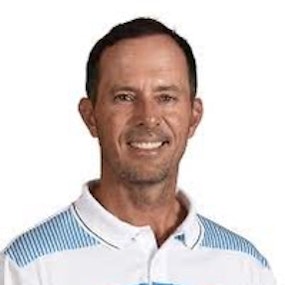
Weir, Mike
Golf Professional
Like most young Canadians, Weir first dreamed of playing professional hockey, but his fate changed when he picked up his first golf club. His determination was first seen as he spent entire days in the summer hitting balls at Huron Oaks under the mentorship of Steve Bennett.
Weir won his first PGA TOUR title at the 1999 Air Canada Championship with a two-stroke victory over Fred Funk, becoming the first Canadian to win on TOUR since Richard Zokol won the 1992 Greater Milwaukee Open, and the first Canadian to win on native soil since Pat Fletcher won the 1954 Canadian Open.
Weir emerged as one of the game’s brightest stars with his Masters victory, a dramatic playoff win over Len Mattiace, and came back to a hero’s welcome in Canada, which included him dropping the ceremonial face-off at a Toronto Maple Leafs playoff game—the perfect ‘Canadian-style’ celebration for the hockey fan Weir.
Mike has competed in five President’s Cups. (2000, 2003, 2005, 2007, 2009) and was named as assistant captain of the 2019 team.
Weir has used his success as a professional golfer as a platform for helping other families in need with the creation of the Mike Weir Foundation in 2004. Mike launched a national fundraising program through his foundation, called the Mike Weir Miracle Golf Drive for Kids, supporting Children’s Miracle Network. The first Mike Weir Miracle Golf Drive tournament in 2007, held at Sunningdale Golf and Country Club in London, Ontario, raised $562,000 for the Children’s Hospital of Western Ontario.
The next phase of Mike’s career now that he has official…
Read More
New to FORE the Good of the Game?
Here are some great episodes to start with. Or, check out episodes by topic.














